Olaf Witkowski
Neurodivergent Influenceability as a Contingent Solution to the AI Alignment Problem
May 15, 2025Abstract:The AI alignment problem, which focusses on ensuring that artificial intelligence (AI), including AGI and ASI, systems act according to human values, presents profound challenges. With the progression from narrow AI to Artificial General Intelligence (AGI) and Superintelligence, fears about control and existential risk have escalated. Here, we investigate whether embracing inevitable AI misalignment can be a contingent strategy to foster a dynamic ecosystem of competing agents as a viable path to steer them in more human-aligned trends and mitigate risks. We explore how misalignment may serve and should be promoted as a counterbalancing mechanism to team up with whichever agents are most aligned to human interests, ensuring that no single system dominates destructively. The main premise of our contribution is that misalignment is inevitable because full AI-human alignment is a mathematical impossibility from Turing-complete systems, which we also offer as a proof in this contribution, a feature then inherited to AGI and ASI systems. We introduce a change-of-opinion attack test based on perturbation and intervention analysis to study how humans and agents may change or neutralise friendly and unfriendly AIs through cooperation and competition. We show that open models are more diverse and that most likely guardrails implemented in proprietary models are successful at controlling some of the agents' range of behaviour with positive and negative consequences while closed systems are more steerable and can also be used against proprietary AI systems. We also show that human and AI intervention has different effects hence suggesting multiple strategies.
Agentic Neurodivergence as a Contingent Solution to the AI Alignment Problem
May 05, 2025Abstract:The AI alignment problem, which focusses on ensuring that artificial intelligence (AI), including AGI and ASI, systems act according to human values, presents profound challenges. With the progression from narrow AI to Artificial General Intelligence (AGI) and Superintelligence, fears about control and existential risk have escalated. This paper demonstrates that achieving complete alignment is inherently unattainable due to mathematical principles rooted in the foundations of predicate logic and computability, in particular Turing's computational universality, G\"odel's incompleteness and Chaitin's randomness. Instead, we argue that embracing AI misalignment or agent's `neurodivergence' as a contingent strategy, defined as fostering a dynamic ecosystem of competing, partially aligned agents, is a possible only viable path to mitigate risks. Through mathematical proofs and an experimental design, we explore how misalignment may serve and should be promoted as a counterbalancing mechanism to team up with whichever agents are most aligned AI to human values, ensuring that no single system dominates destructively. The main premise of our contribution is that misalignment is inevitable because full AI-human alignment is a mathematical impossibility from Turing-complete systems which we also prove in this paper, a feature then inherited to AGI and ASI systems. We introduce and test `change-of-opinion' attacks based on this kind of perturbation and intervention analysis to study how agents may neutralise friendly or unfriendly AIs through cooperation, competition or malice.
On Creativity and Open-Endedness
May 28, 2024Abstract:Artificial Life (ALife) as an interdisciplinary field draws inspiration and influence from a variety of perspectives. Scientific progress crucially depends, then, on concerted efforts to invite cross-disciplinary dialogue. The goal of this paper is to revitalize discussions of potential connections between the fields of Computational Creativity (CC) and ALife, focusing specifically on the concept of Open-Endedness (OE); the primary goal of CC is to endow artificial systems with creativity, and ALife has dedicated much research effort into studying and synthesizing OE and artificial innovation. However, despite the close proximity of these concepts, their use so far remains confined to their respective communities, and their relationship is largely unclear. We provide historical context for research in both domains, and review the limited work connecting research on creativity and OE explicitly. We then highlight specific questions to be considered, with the eventual goals of (i) decreasing conceptual ambiguity by highlighting similarities and differences between the concepts of OE, (ii) identifying synergy effects of a research agenda that encompasses both OE and creativity, and (iii) establishing a dialogue between ALife and CC research.
Hybrid Life: Integrating Biological, Artificial, and Cognitive Systems
Dec 01, 2022Abstract:Artificial life is a research field studying what processes and properties define life, based on a multidisciplinary approach spanning the physical, natural and computational sciences. Artificial life aims to foster a comprehensive study of life beyond "life as we know it" and towards "life as it could be", with theoretical, synthetic and empirical models of the fundamental properties of living systems. While still a relatively young field, artificial life has flourished as an environment for researchers with different backgrounds, welcoming ideas and contributions from a wide range of subjects. Hybrid Life is an attempt to bring attention to some of the most recent developments within the artificial life community, rooted in more traditional artificial life studies but looking at new challenges emerging from interactions with other fields. In particular, Hybrid Life focuses on three complementary themes: 1) theories of systems and agents, 2) hybrid augmentation, with augmented architectures combining living and artificial systems, and 3) hybrid interactions among artificial and biological systems. After discussing some of the major sources of inspiration for these themes, we will focus on an overview of the works that appeared in Hybrid Life special sessions, hosted by the annual Artificial Life Conference between 2018 and 2022.
Two Ways of Understanding Social Dynamics: Analyzing the Predictability of Emergent of Objects in Reddit r/place Dependent on Locality in Space and Time
Jun 02, 2022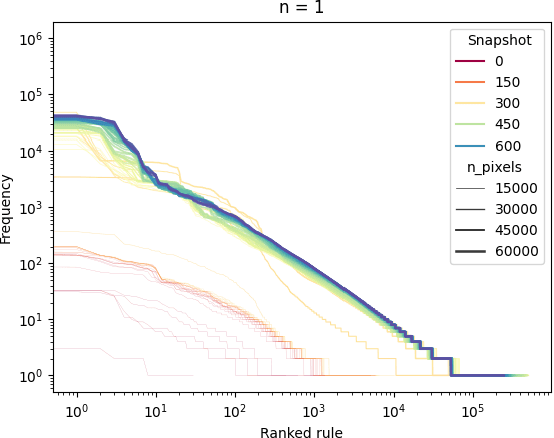
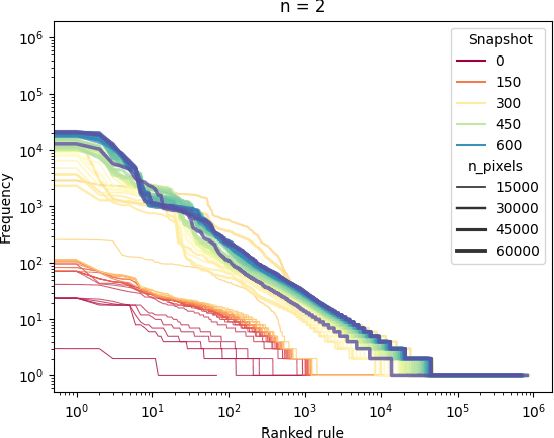
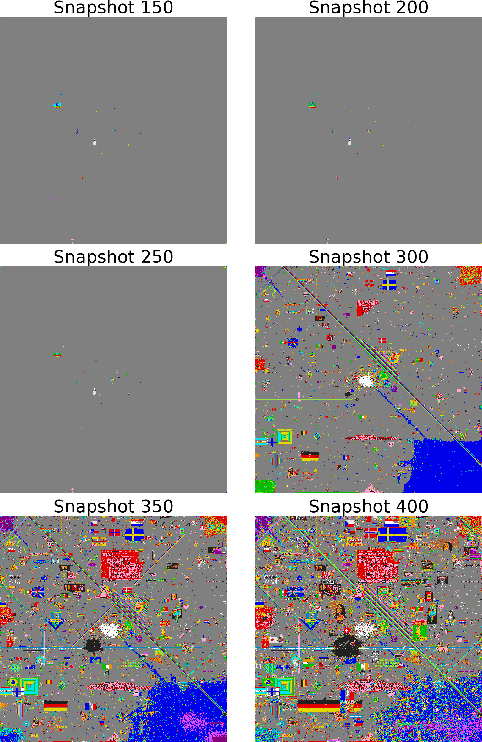
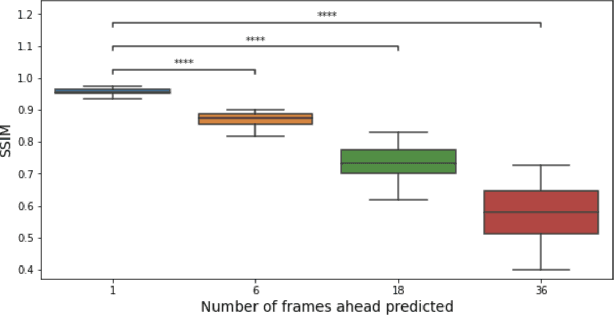
Abstract:Lately, studying social dynamics in interacting agents has been boosted by the power of computer models, which bring the richness of qualitative work, while offering the precision, transparency, extensiveness, and replicability of statistical and mathematical approaches. A particular set of phenomena for the study of social dynamics is Web collaborative platforms. A dataset of interest is r/place, a collaborative social experiment held in 2017 on Reddit, which consisted of a shared online canvas of 1000 pixels by 1000 pixels co-edited by over a million recorded users over 72 hours. In this paper, we designed and compared two methods to analyze the dynamics of this experiment. Our first method consisted in approximating the set of 2D cellular-automata-like rules used to generate the canvas images and how these rules change over time. The second method consisted in a convolutional neural network (CNN) that learned an approximation to the generative rules in order to generate the complex outcomes of the canvas. Our results indicate varying context-size dependencies for the predictability of different objects in r/place in time and space. They also indicate a surprising peak in difficulty to statistically infer behavioral rules towards the middle of the social experiment, while user interactions did not drop until before the end. The combination of our two approaches, one rule-based and the other statistical CNN-based, shows the ability to highlight diverse aspects of analyzing social dynamics.
CLIPDraw: Exploring Text-to-Drawing Synthesis through Language-Image Encoders
Jun 28, 2021



Abstract:This work presents CLIPDraw, an algorithm that synthesizes novel drawings based on natural language input. CLIPDraw does not require any training; rather a pre-trained CLIP language-image encoder is used as a metric for maximizing similarity between the given description and a generated drawing. Crucially, CLIPDraw operates over vector strokes rather than pixel images, a constraint that biases drawings towards simpler human-recognizable shapes. Results compare between CLIPDraw and other synthesis-through-optimization methods, as well as highlight various interesting behaviors of CLIPDraw, such as satisfying ambiguous text in multiple ways, reliably producing drawings in diverse artistic styles, and scaling from simple to complex visual representations as stroke count is increased. Code for experimenting with the method is available at: https://colab.research.google.com/github/kvfrans/clipdraw/blob/main/clipdraw.ipynb
Selecting for Selection: Learning To Balance Adaptive and Diversifying Pressures in Evolutionary Search
Jun 16, 2021
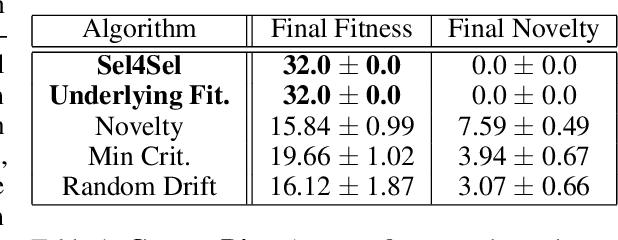

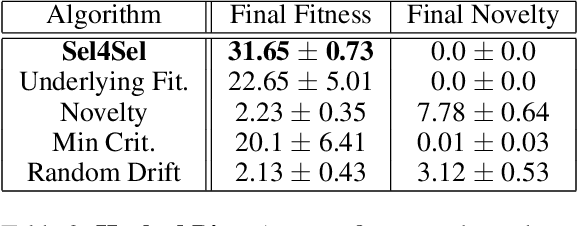
Abstract:Inspired by natural evolution, evolutionary search algorithms have proven remarkably capable due to their dual abilities to radiantly explore through diverse populations and to converge to adaptive pressures. A large part of this behavior comes from the selection function of an evolutionary algorithm, which is a metric for deciding which individuals survive to the next generation. In deceptive or hard-to-search fitness landscapes, greedy selection often fails, thus it is critical that selection functions strike the correct balance between gradient-exploiting adaptation and exploratory diversification. This paper introduces Sel4Sel, or Selecting for Selection, an algorithm that searches for high-performing neural-network-based selection functions through a meta-evolutionary loop. Results on three distinct bitstring domains indicate that Sel4Sel networks consistently match or exceed the performance of both fitness-based selection and benchmarks explicitly designed to encourage diversity. Analysis of the strongest Sel4Sel networks reveals a general tendency to favor highly novel individuals early on, with a gradual shift towards fitness-based selection as deceptive local optima are bypassed.
Population-Based Evolution Optimizes a Meta-Learning Objective
Mar 11, 2021



Abstract:Meta-learning models, or models that learn to learn, have been a long-desired target for their ability to quickly solve new tasks. Traditional meta-learning methods can require expensive inner and outer loops, thus there is demand for algorithms that discover strong learners without explicitly searching for them. We draw parallels to the study of evolvable genomes in evolutionary systems -- genomes with a strong capacity to adapt -- and propose that meta-learning and adaptive evolvability optimize for the same objective: high performance after a set of learning iterations. We argue that population-based evolutionary systems with non-static fitness landscapes naturally bias towards high-evolvability genomes, and therefore optimize for populations with strong learning ability. We demonstrate this claim with a simple evolutionary algorithm, Population-Based Meta Learning (PBML), that consistently discovers genomes which display higher rates of improvement over generations, and can rapidly adapt to solve sparse fitness and robotic control tasks.
How to Make Swarms Open-Ended? Evolving Collective Intelligence Through a Constricted Exploration of Adjacent Possibles
Mar 19, 2019Abstract:We propose an approach of open-ended evolution via the simulation of swarm dynamics. In nature, swarms possess remarkable properties, which allow many organisms, from swarming bacteria to ants and flocking birds, to form higher-order structures that enhance their behavior as a group. Swarm simulations highlight three important factors to create novelty and diversity: (a) communication generates combinatorial cooperative dynamics, (b) concurrency allows for separation of timescales, and (c) complexity and size increases push the system towards transitions in innovation. We illustrate these three components in a model computing the continuous evolution of a swarm of agents. The results, divided in three distinct applications, show how emergent structures are capable of filtering information through the bottleneck of their memory, to produce meaningful novelty and diversity within their simulated environment.
Permutation-equivariant neural networks applied to dynamics prediction
Dec 14, 2016



Abstract:The introduction of convolutional layers greatly advanced the performance of neural networks on image tasks due to innately capturing a way of encoding and learning translation-invariant operations, matching one of the underlying symmetries of the image domain. In comparison, there are a number of problems in which there are a number of different inputs which are all 'of the same type' --- multiple particles, multiple agents, multiple stock prices, etc. The corresponding symmetry to this is permutation symmetry, in that the algorithm should not depend on the specific ordering of the input data. We discuss a permutation-invariant neural network layer in analogy to convolutional layers, and show the ability of this architecture to learn to predict the motion of a variable number of interacting hard discs in 2D. In the same way that convolutional layers can generalize to different image sizes, the permutation layer we describe generalizes to different numbers of objects.
 Add to Chrome
Add to Chrome Add to Firefox
Add to Firefox Add to Edge
Add to Edge